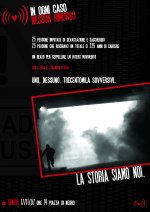

astasiempre - l'asta
Cerca
Navigazione
GLF e Segreteria Legale
DOCTOR THAT AUTOPSIED CARLO GIULIANI: "CAT SCAN SHOWED FRAGMENT BUT WE DIDN'T FIND IT
The 60th hearing in the trial against the 25 demonstrators accused of looting and sacking during the Genoa G8 events in 2001. Once again, one of the Carabinieri officials that played a key role in events in Piazza Alimonda was conspicuous by his absence.
The missing individual this time, was Carabinieri Colonel Giovanni Truglio*, at the time, a colonel lieutenant and commander of the CCIR (the Carabinieri riot squad created specifically for the G8 and dissolved afterwards). Truglio presented a valid medical certificate for his absence.
So events got under way with the testimony of a prosecution witness, Marco Salvi, the author of the report into Mario Placanica and one of the two doctors who autopsied Carlo Giuliani's body. The defence called him in relation to the autopsy, in an attempt to verify its reliability (the autopsy was branded "superficial" by Public Prosecutor Franz himself, who successfully requested that judicial proceedings into Piazza Alimonda be dismissed). The prosecution also questioned the witness regarding the account given by Raffone, the other auxiliary in Placanica's Defender, who testified in the tribunal some months ago. The court accepted both reservations, and after a break, the hearing began. But between the court's decision to admit the witness and his questioning, the Chief Inspector of the Milanese Digos Security Police Marco Cavalli was summoned to identify some of the defendants. As usual, the transfer of material used for identification between different forces was muddled and delayed. The prosecution didn't help the situation, as usual, presenting the findings in a vague and imprecise manner. This considerably slowed down the questioning.
Cavalli identified two of the witnesses on the basis of photos and videos sent by the Genoese Digos to the Milanese branch.
He was absolutely convinced of the defendants' identity, even in distorted photos and even in situations when he wasn't present. Just for good measure, he also identified another eight Milanese militants that had no connection with the trial, in some cases reading the names directly from his report. Cavalli was eventually allowed off the stand, although he will have to return for the defence's cross-examination.
Salvi then returned to the courtroom to be questioned by the prosecution and the defence. The prosecution's examination was brief and it was left up to the defence to test the witness's reliability. Salvi answered questions put by Menzione, recalling that the CAT scan of Carlo Giuliani's body "showed a bullet fragment" that was not found during the autopsy. "Was it that you didn’t look for it or that you didn't find it?" asked Menzione. "We didn't find it," Salvi replied. It should be underlined that that fragment could have revealed a great deal about the characteristics of the bullets being used that day (the unfired bullets were never found), casting light on numerous aspects of events in Piazza Alimonda that are still unclear.
After Placanica's refusal to speak at the last hearing, it can only be hoped that Colonel Truglio, the other key player in Carlo Giuliani's shooting on July 20, will give evidence soon.
* During the Genoa G8 events, Truglio was commander of the five CCIRs, the Carabinieri riot squads set up specifically for the G8 and kitted out with new weapons and equipment.
Like his "colleagues" Claudio Cappello and General Leonardo Leso, Truglio has long been part of the Italian military elite abroad. His feats in Somalia, for example, are linked to a famous episode better known as Check Point Pasta, which resulted in the death of hundreds of Somalis. General Loi, who commanded the Italian troops in Somalia during Mission Ibis, recalled the events in his book "Peacekeeping: Peace Or War?" (published by Castelvecchi) in which Truglio distinguished himself, receiving a slight injury in the crossfire. Truglio is also mentioned in Marshal Aloi's famous diary in connection with Somalia. Discussing Italian soldiers' alleged torture of Somalis, Aloi described Truglio as someone who was well-informed of what really happened. Although these events prompted an inquiry, it came to nothing.
Truglio's current resume can be accessed at the website of the European Union Force in Bosnia and Herzegovina (EUFOR) (http://www.euforbih.org/commanders/ipu/t050505a.htm). Born in 1959 in the province of Cosenza, he has participated in numerous foreign missions since 1989: in Somalia, Albania, Iraq and recently Bosnia. In September 2004 he became commander of the Multinational Specialized Unit (MSU) and, in December, of the Integrated Police Unit (IPU). Having returned to Italy, he was replaced in this post just a few days ago, on September 26, 2005.
Truglio was the commander of the CCIR contingents in Genoa. His name was frequently mentioned in the depositions of various witnesses during proceedings into the 25 demonstrators charged with looting and sacking. Lieutenant Mirante, who headed one of the companies commanded by Truglio, gave a deposition that blended military techniques and tactics, with Carabinieri fairytales. In this, he recalled it was Truglio who had told him "perhaps your driver has run someone over". Truglio therefore seems to be the umpteenth witness - after Placanica's silence - with knowledge about what happened in Piazza Alimonda who is instead heading towards a swamp of reticence, doubts and withheld information.
Supporto Legale
supportolegale.org
La Storia Siamo Noi




